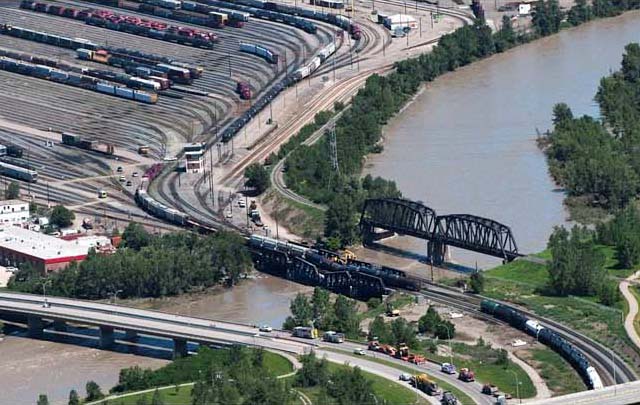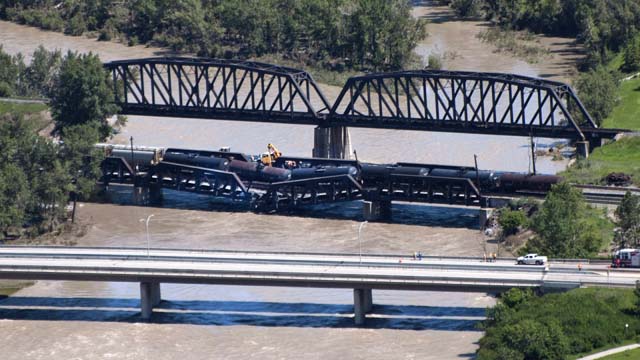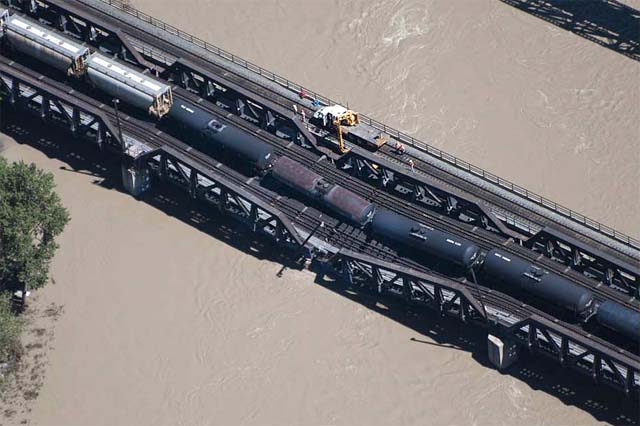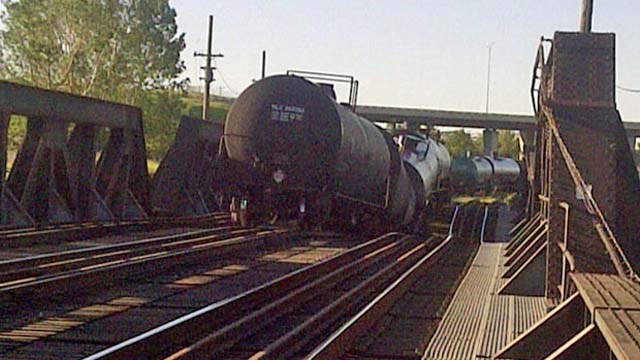|

|


Areal photo of the area surrounding the Bonnybrook bridge - 27 Jun 2013 Larry MacDougal.
27 June 2013
Calgary Mayor Lashes Out at CP Rail
Over Train Stranded on Bridge
Calgary Alberta - With Calgary's partially collapsed CP rail bridge "stabilized somewhat," Mayor Naheed Nenshi is lashing out
at the company, questioning whether they had enough bridge inspectors and saying the city should have jurisdiction to inspect rail bridges.
His comments led CP chief executive officer Hunter Harrison to arrive at the mayor's emergency operation centre later in the day, saying the 1912 bridge's
supports simply failed and that there was no way to see it coming.

A closer areal photo of the Bonnybrook bridge - 27 Jun 2013 Larry MacDougal.

Areal photo of the area surrounding the Bonnybrook bridge - 27 Jun 2013 Larry MacDougal.

The Bonnybrook bridge - 27 Jun 2013 Photographer unknown.
The aging bridge partially collapsed around 3:30 a.m. Thursday morning as a 102-car train rolled across it. The neighbourhood has since been evacuated. Six
cars remain stranded on the sagging bridge, five of them carrying petroleum products.
The bridge was inspected Saturday, when the Bow River was still raging. Mr. Nenshi asked why it hadn't been inspected since, while Mr. Harrison said there was
no way to do a full inspection below surface.
"We couldn't have seen anything from an inspection on top unless there was severe movement as a result of the failure down below," Mr. Harrison said.
"So, we would have normally probably put divers in to inspect, but the current was too fast."
Asked why the company then didn't wait until the current slowed to resume train trips, Mr. Harrison replied: "We didn't anticipate a problem like
this occurring at all. And how long was that going to be? We're jeopardizing commerce as it speaks. We had no idea that there was any compromise of safety
whatsoever."
Currently, railways are the only private businesses municipalities can't touch, and Mr. Nenshi said the city should have some authority over their
infrastructure, such as the century-old bridge.
"How is it we don't have regulatory authority over this, but it's my guys down there risking their lives to fix it," the mayor said, later
adding: "We have to have a serious conversation about this. This is a private business, and private businesses are subject to
regulation."
City bridges have been inspected three times since the flood, and are safe, he said. They're built almost three metres into bedrock.
Mr. Harrison said the CP bridge was inspected five times, including informal visual inspections, but acknowledged it's not on bedrock. The train was going 14
km/h at the time of the derailment, which is under the limit, he said.
CP has said it expects to let go 4,500 employees and contractors by 2016. The company's own figures show both collisions and injuries have increased in
frequency over the past year. Mr. Nenshi asked whether bridge inspectors were also laid off.
"We've seen a lot of people lose their jobs at CP over the last year. How many bridge inspectors did they fire? These are the questions that we need to
understand much, much, better," he said. "I have a lot of questions and not very many answers right now," he said.
The company has not laid off any inspectors, Mr. Harrison said.
"No engineering people have been laid off. Mechanical? Yes. Operating? Yes. Headquarters and administrative? Yes. We've talked publicly about the
downsizing, but we've not done anything with engineering personnel, or bridge inspectors, or supervisors of the bridge inspectors," he said.
Early fears of a spill were abating by the afternoon. By 2 p.m. local time, officials had tethered the cars together and tied them to an anchor of sorts,
another train with cars filled with rocks. Even if the bridge does collapse, the cars won't float down the river. Officials will now try to empty the cars of
their load, they each weigh about 35 tonnes, before removing them from the bridge by either dragging them or hoisting them with a crane.
The derailment shuttered a major Calgary artery, Deerfoot Trail, for 10 hours and diverted city crews away from flood response and also forced the evacuation
of a waste-water treatment plant, meaning sewage is currently flowing untreated into the major river.
CP spokesman Ed Greenberg said the company has an extensive maintenance and inspection program. "Safety is a priority of this railway and it is a priority
that will not change," he said.
Visiting the derailment scene, Alberta Transportation Minister Ric McIver said the province's bridges are generally safe.
"The bridges are in good shape. Obviously something happened here that will have to be investigated later, but right now the focus is on safety of people,
safety of infrastructure, and of course getting the freeway open again," he said, declining to comment on what role the flood played in the CP bridge's
collapse.
"The wider public today needs to have confidence that there are very good professionals working on this," he said.
Once the evacuation order is lifted, the waste-water treatment plant can be reopened, the mayor said. Meanwhile, the city has warned officials downstream, but
said that such a case is common, though regrettable, in the aftermath of a flood. "The waste water is flowing directly through the plant at this
moment," he said. "This is not a situation we like."
Shortly after 11 a.m., two large metal temporary bridges, each approximately 15 metres long, arrived at the derailment site. Downton's Oilfield Services hauled
them in from Red Deer, about an hour north of Calgary. They are waiting for the rail cars to be unloaded before installing the bridges, a driver
said.
It's unclear what's in the cars. CP said all five are carrying petroleum distillate, a type of diluent used to water down oil sands bitumen for shipment. It's
also used as a solvent in metal polishes, paint thinner, oil-based stains, and paint, the rail company said.
Calgary officials said four are carrying petroleum products, presumably distillate, but that one is carrying ethylene glycol, which is used as a solvent and in
antifreeze.
The fluids are flammable, but not necessarily dangerously explosive, city officials said.
"All of those are not the safest of materials. Certainly we don't want any of it in the water," Mr. Nenshi said.
Crews are setting up booms downstream, to catch some of the diluent if it is ultimately spilled.
Images from the scene show a single section has buckled, and is facing down toward the river. Acting Fire Chief Ken Uzeloc said that section dropped two feet
between 4:30 a.m. and 6 a.m. local time. But, at 8 a.m., Mr. Uzeloc said the bridge hadn't moved in 45 minutes. It has remained stable since 9 a.m. local time,
the City of Calgary said.
"It's partially in the water, but it has not moved in the last 3-1/2 hours," Mr. Uzeloc said Thursday afternoon. "It has not moved further so we
think it's relatively stable at this point."
Mr. Harrison said it's safe to assume the flooding led to the partial collapse.
"The pier failed, got loose in the footing which was gravel, effectively. Not bedrock. It's a 1912 bridge. Although it should last a lot longer, under
"normal" circumstances. And when it failed, it tilted, caused additional pressure, and it cracked. And when it cracked, it dropped down, and as a
result of it dropping down, those cars, those six cars, derailed on the bridge," he said, adding most of the train made it across before the bridge gave
way.
As of Thursday, 18 communities remained under declared states of emergency. The Town of High River, remained the worst hit, and was under a full evacuation
order.
Provincial officials planned by noon Thursday to begin handing out pre-loaded cash cards to evacuees, starting with High River residents. Those in the first
half of the alphabet were able to get the cards Thursday, and a long line was already forming Thursday morning at one of the two distribution sites. The cards
will offer $1,250 per adult and $500 per child in a family, and are meant as bridge funding to those displaced by last week's flood.
Nine highways remain closed, while another two are only partially open.
Calgary expects its state of emergency to continue for another week, with Mr. Nenshi setting Canada Day as a target for people to return to the downtown. The
Calgary Stampede is set to begin 5 Jul 2013, and officials have pledged to go ahead "come hell or high water."
Residents of High River remain frustrated they can't access their town, but provincial officials say electrical issues, public health hazards, sinkholes, and
persistent flooding simply make it unsafe.
Premier Alison Redford said Wednesday she sympathizes with the frustrated evacuees.
"I think about it every hour, I think about it every night," she said, adding: "We want to do the re-entry in a safe way." Mr. Nenshi
said Thursday's bridge collapse underscores the risks that persist, even as water levels drop.
High River's mayor has said he expects residents can return within days.
Alberta's Lieutenant Governor Donald Ethell released a statement on the floods Thursday, saying his thoughts "go out to all those who have suffered losses
and particularly those who are mourning victims of the flood."
Mr. Ethell also praised the volunteers who've helped those displaced by the floods.
"The tremendous compassion and the strength of community demonstrated by all, neighbours and strangers alike, offers a powerful example of the Alberta
spirit," he said.
Josh Wingrove and Jeffrey Jones.



Vancouver Island
British Columbia
Canada
|




